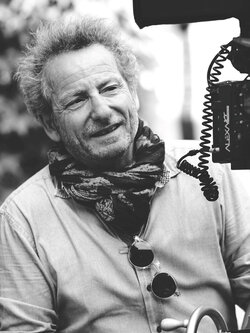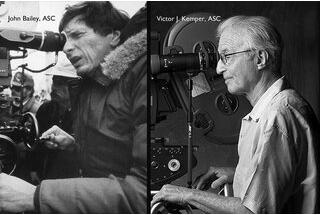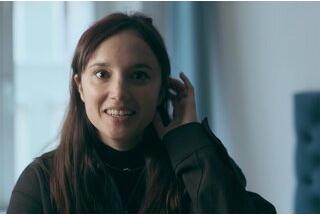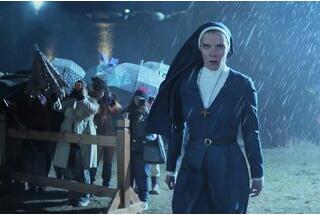Conversation with Guillaume Schiffman, AFC, and the director Michel Hazanavicius about their collaboration on "The Search"
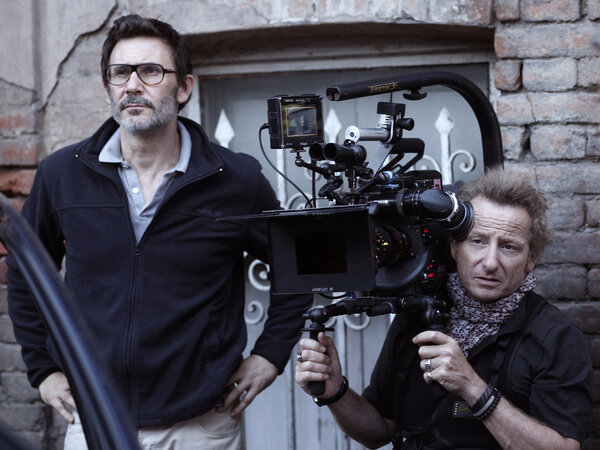
What was the context in which you began work on The Search?
Michel Hazanavicius: I wanted to make a “local” and authentic war movie on a little-discussed subject — Chechnya — with the budget of an international film (20 million). This is a pretty hard sell to the powers-that-be, because it goes against the rules of the market. But following the success of The Artist, I had more or less a free hand to produce my next movie.
My main goal was to strike the right balance between realism and romance. In this respect, the example of the war movie is particularly eloquent: either the director forgets about realism, such as by accepting that all the characters speak English, for example, or deep down doesn’t really care about where it’s all taking place… Or, on the contrary, he is handcuffed by his absolute fidelity to the subject and forgets to tell a cinematographic story. It is precisely by trying to strike the right balance that this film was made, by trying to maintain a certain respect for the human being without neglecting to tell a story.
And at the heart of the medium of cinema, is of course the image… This led to our decision to film from the shoulder without using a Steadicam.
Did you have particular pictures or movies in mind?
MH: In fact, I’m not too crazy about war movies. If I had to name one, it would be The Deer Hunter, which is more of a social movie about friendship than a true war movie in the pure sense of the term... My inspiration came mainly from war photos showing faces of civilians or soldiers, rather than shots of battlefields or explosions. At the same time, when you start shooting, especially the large crowd scenes, one finds oneself caught up by the need to tell a story. Involuntarily, those faces become secondary... almost by the force of the circumstances. You spend many exhausting hours setting all of those people up, most of whom are awful on screen! Even to the point that I ended up filming the shots when they would go back to their places between “shots” instead of between “Action” and “Cut”, by secretly reversing the directions of their movement… This is why I decided to give carte blanche to the image team, so that they could discretely bring me close ups that I wasn’t sure what to do with, but that ended up being as valuable as the rest when we cut the film. This also helped us put the human back at the centre of our narrative.
Seeing the first images, the reconstruction is very realistic. What did you draw upon in order to create the image of Chechnya?
MH: There are very few images from this war. No film to my knowledge, and only a few news images that were filmed in early winter 1999-2000. We began working from that sole visual documentation of the event, and tried to stick to a documentary spirit. Of course, we weren’t going to film on video like TV journalists used to do at that time, but we wanted a set up that would give a raw and authentic aspect to the film image. William suggested working using an Easy Rig and a zoom, which gave us a visual style very close to that of a television report. And then we had the idea of filming using silver-process film and bleach bypass.
Guillaume Schiffman: As soon as I read the script, I felt that it was necessary that this movie be filmed using silver-process negative. And then when Michel spoke with me about the importance of the human, of faces, and all of those people we were going to film... I thought that 35mm developed with bleach bypass would return us the material that we no longer have access to with digital photography and would allow us to attain that equilibrium between a “documentary” image and cinematic fiction. Not to mention the parameter of the season: the film had to be shot between summer and autumn 2013, and I was afraid that the overly saturated colours, especially green, would bother us in terms of setting the proper image to recreate the winter ambience visible on the images from 1999.
In the digital age, this is a very rare decision, is it not?
GS: Shooting a film using entirely 35mm in Georgia for sixteen weeks in 2013 is indeed something that is difficult to get a producer to accept... But when you add the risk of developing with bleach bypass, it becomes almost impossible! But with the support and desire of Michel and the trust that the producers placed in us, we were able to do it.
From a logistical standpoint, the reels went via Turkey to France, where they were developed by Technicolor. We only got the dailies three days later, which caused us quite a bit of stress when it came to the scenes with 1000 extras! But in the end, everything went smoothly, except for one day when the bleach bypass was botched.
MH: I remember the first tests we did in Paris, with the key grip dressed as a soldier, posing in a parking lot! We tested everything that we were considering using on the film, from classic negative film stock, to bleach bypass, and of course, digital. The result of the bleach bypass, especially on the faces, immediately appealed to me.
What does this change for the DoP?
GS: It is very pleasant, because unlike modern camera technique (either digital or silver process), the art of posing once again becomes a true challenge, almost like during the age of reversal film. The bleach bypass augments the contrast, and you have a very slim margin of manoeuvre in terms of over- and underexposure.
You have to know when to let up after a certain point, otherwise you’ll get very white or very dark images! With digital colour timing at the end, now you can fix a lot of things that you couldn’t twenty years ago with classic colour timing methods.
Did it take you more time on set?
GS: The film was shot in fourteen weeks, but given the complexity of the setups, and the five languages spoken on set, I can tell you that I didn’t have much time for the lighting. Once the ball was rolling, we had to push through and try to shoot as many scenes as possible during the day. Most of the work was done in advance, with three previous visits to Georgia, during which we were able to put everything down on paper and plan a shooting schedule in advance for the shoulder camera. This was very different than the other films (OSS 177, The Artist) that were heavily story-boarded.
What about the lenses?
GS: We shot most of the time with the new lightweight Angenieux 45-120mm zoom, which we used almost all the time at minimum aperture and the 15-40mm for a few wide shots. Sometimes I used a Cooke S4 series for nighttime shots or some dialogue scenes that were more “posed”. We used absolutely no diffusers or filters of any kind, which was a first for me on close-ups of actresses like Anette Bening or Bérénice Bejo. Bleach bypass accentuates any shininess and shadows, and even after colour timing, I think that we discover a completely different face on Bérénice, with her freckles and small scar, which are usually hidden by the light and makeup.
The choice to shoot with zooms allowed us to do the staging very rapidly. Michel would change shot types in the middle of a shot in order to focus in on a face or an expression, despite the fact that the shot had begun wide or medium. For me it was more difficult because the lighting had to keep up, and it was rare that I was actually able to change equipment for the close-ups.
In terms of lighting, I mostly opted for sources placed off screen, and the fewest possible spotlights on set. This was to avoid distracting the many non-professional actors whose attention was quickly distracted by whatever peripheral movements the technical team would make...
At the same time, Michel was very vigilant to make sure the light remained realistic, calling me to task several times when a shadow seemed too artificial or a composition too affected.
MH: The against-the-light shots, for example! It’s almost automatic on set to make sure there’s a little bit of against-the-light on the actress… Here, we quickly realized that that didn’t work. So we didn’t use any in this film! Same went for me, I was often tempted to use a dolly but forewent it. Instead, a wheelchair did the trick.
What is the "look" documentary imposes a certain absence of light?
GS: Whilst preparing, I remember that Michel told us that this was not a movie where you could play around! Decoration, costumes, visuals… everything had to be done discreetly and had to appear just the right way, because once they were in the frame, they became extremely important. So the temptation would have been not to light.
But as a cinematographer, you know that that’s not how it works. On the contrary, I think that you really have to work with the light so that it isn’t visible, just in the same way that Michel had to be very precise and demanding on the scenography in order so that it wouldn’t be noticeable either.
And then we didn’t have an unlimited budget… We couldn’t film for six months and wait for good natural light for every shot the way that some American directors can!
Were some scenes more complex than others to shoot?
GS: The film has a lot of cuts, but there were a couple of long takes that were very complex. To make them easier, I called on Rodolphe Lauga, a Steadicam operator, but who only did shoulder takes. One of the most difficult was the four-minute-long nighttime shot that began outside in the rain, crossed two enormous rooms full of soldiers lit with braseros, and ended with an intimate dialogue scene in a staircase. It was a real challenge for me as a camera operator. With nearly fourteen rehearsals and eight takes, I didn’t regret calling on him. But you won’t see him because we cut that shot out during editing!
MH: It’s true that it was a very lovely long take… Maybe it was even a little too cinematic! All jokes aside, that scene was in the screenplay simply to make the story more understandable. And then when the film takes shape during editing, sometimes these things ooze from every pore of the film. In this case, that scene had become a sort of pleonastic reference to disillusionment with the notion of heroism. But I will include it with the bonuses when it is released on DVD!
Was it hard to resist the temptation to make things more “cinematographic” while shooting this film?
MH: Fatigue is a trap. Fourteen weeks is forever! You can fall into a sort of complacency, and you have to deal with the temptation to go towards what you’re comfortable doing versus sticking to what you set out to do at the beginning. It’s hard to stay the course and not to fall prey to the spectacular side of war, with all its machinery, the helicopters that take off with everyone on set stopping to watch...
Thus doing, you glorify a very cinematographic type of adrenaline and you stray from your goal. And this effort can’t stop once filming has come to a close. You also have to continue afterwards, during editing…
You have to say no to multichannel sound effects in order to remain true to the capacities of the human ear. Otherwise, the image isn’t seen in the same way. The same goes for the music, and we chose to forego a “score” and to only include music justified by what is happening on screen. During colour timing, we made sure that the image remained humble, because it is very tempting to “make the visuals look nice” with modern technologies. I hope that we attained our goal!
(Interview conducted by François Reumont for the AFC and translated from French by Alex Raiffe)
 En
En
 Fr
Fr